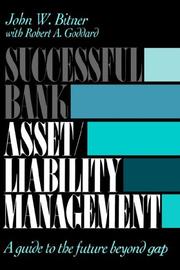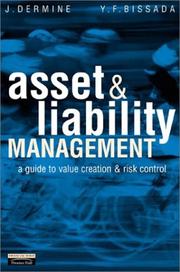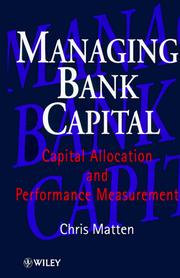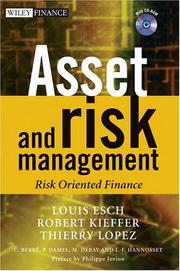| Listing 1 - 10 of 21 | << page >> |
Sort by
|

ISBN: 0471527319 9780471527312 Year: 1992 Publisher: New York (N.Y.): Wiley,
Abstract | Keywords | Export | Availability | Bookmark
 Loading...
Loading...Choose an application
- Reference Manager
- EndNote
- RefWorks (Direct export to RefWorks)

ISBN: 0273656562 9780273656562 Year: 2002 Publisher: Harlow Financial Times/Prentice Hall
Abstract | Keywords | Export | Availability | Bookmark
 Loading...
Loading...Choose an application
- Reference Manager
- EndNote
- RefWorks (Direct export to RefWorks)
Asset-liability management. --- Asset-liability management --- 332.645 --- Hc2 --- Asset-liability management (Banking) --- Funds management --- Financial institutions --- Management --- Investments

ISBN: 0521584116 0511559712 9780521584111 9780511559716 Year: 1998 Publisher: Cambridge Cambridge University Press
Abstract | Keywords | Export | Availability | Bookmark
 Loading...
Loading...Choose an application
- Reference Manager
- EndNote
- RefWorks (Direct export to RefWorks)
This book relates the literatures of finance, industrial economics and investment to the theoretical framework of the 'credit view'. Firstly it is assumed that banks' decisions concerning their assets are seen as at least as relevant as their decisions concerning their liabilities. Secondly, securities and bank credit are considered to be highly imperfect substitutes. In this regard it is important to investigate the way industrial and financial sectors interact. In particular, how is the macroeconomy affected by the phenomenon of 'securitization' and by exogenous changes in the industrial structure of the credit market. The interactions between real and financial sectors are also analysed from the point of view of the industrial firm, in a model where the investment and financial decisions of the firm are taken simultaneously.
Credit --- Asset-liability management --- Macroeconomics --- 339 --- Economics --- Asset-liability management (Banking) --- Funds management --- Financial institutions --- Borrowing --- Finance --- Money --- Loans --- Management --- Investments --- Asset-liability management. --- Credit. --- Macroeconomics. --- Business, Economy and Management

ISBN: 047197465X 0471974668 9780471974666 9780471974659 Year: 1998 Publisher: Chichester Wiley
Abstract | Keywords | Export | Availability | Bookmark
 Loading...
Loading...Choose an application
- Reference Manager
- EndNote
- RefWorks (Direct export to RefWorks)
Bank management. --- Risk management. --- Asset liability management (Banking) --- Banques --- Gestion du risque --- Gestion des actifs et passifs bancaires --- Direction --- Bank management --- Risk management --- Asset-liability management --- 332.10681 --- 332.6 --- Asset-liability management (Banking) --- Funds management --- Financial institutions --- Insurance --- Management --- Banks and banking --- Investments --- Asset-liability management.
Book
ISBN: 9781439821305 1439821305 1322615934 0429062702 1439821321 9780429062704 1040053254 Year: 2011 Publisher: Boca Raton, FL : CRC Press,
Abstract | Keywords | Export | Availability | Bookmark
 Loading...
Loading...Choose an application
- Reference Manager
- EndNote
- RefWorks (Direct export to RefWorks)
Reflecting the author's wealth of experience in this field, Handbook of Solvency for Actuaries and Risk Managers: Theory and Practice focuses on the valuation of assets and liabilities, the calculation of capital requirement, and the calculation of the standard formula for the European Solvency II project. The first three sections of the book examine the solvency concept, historical development, and the role of solvency in an enterprise risk management approach. The text provides a general discussion on valuation, investment, and capital, along with modeling and measuring. It also covers depen
Risk (Insurance) --- Asset-liability management --- Risk management --- Asset-liability management. --- Risk management. --- 368 --- Verzekeringswezen --- Risk (Insurance). --- 368 Verzekeringswezen --- Insurance --- Management --- Asset-liability management (Banking) --- Funds management --- Financial institutions --- Risk --- Investments --- Risk (Insurance) - European Union countries --- Asset-liability management - European Union countries --- Risk management - European Union countries

ISBN: 0471961167 9780471961161 Year: 1996 Publisher: Chichester: Wiley,
Abstract | Keywords | Export | Availability | Bookmark
 Loading...
Loading...Choose an application
- Reference Manager
- EndNote
- RefWorks (Direct export to RefWorks)
Bank capital --- Bank investments. --- Asset allocation. --- Asset-liability management. --- Risk management.
Book
ISBN: 3527509186 9783527509188 Year: 2017 Publisher: Weinheim, Germany: Wiley-VCH,
Abstract | Keywords | Export | Availability | Bookmark
 Loading...
Loading...Choose an application
- Reference Manager
- EndNote
- RefWorks (Direct export to RefWorks)
In reaction to the financial market crisis that started in 2007, the Basel Committee on Banking Supervision substantially revised its existing framework for regulation, supervision and risk management in the banking sector. This revision was introduced with the so-called Basel III framework in December 2010. It essentially comprises a strengthening of the quality of a banks' own funds, as well as new requirements with regard to the amount of required capital. Furthermore, new ratios were introduced in order to limit the leverage employed by banks as well as new liquidity ratios. Since 2012 the Basel Committee has increasingly pursued a revision of the calculation methods for risk-weighted assets. In addition, a large number of new requirements have been developed. This package of new standards from the Basel Committee, which is unofficially called "Basel IV", is now the most comprehensive package of modifications in the history of banking supervision. It is only a matter of time until the innovations of the Basel IV package are transferred into binding EU law. The banking industry will face major challenges in implementing these new rules. In the editor's volume "Basel IV - The Next Generation of Risk Weighted Asset" Martin Neisen and Stefan Roth present the current edition of the Basel reform proposals. The aim is to convince the reader that we are facing a new framework called "Basel IV" and not just a fine adjustment of the existing Basel III regulations. Moreover, the innovations of the Basel IV package are explained in a clear, comprehensible and practical manner. With the aid of a high-profile team of experts, the complexity of the topic is reduced and important support is offered.
Banks and banking --- Bank management --- Asset-liability management --- Credit --- Risk management --- Commercial credit
Book
ISBN: 9780470019139 9780470019122 0470019123 0470019131 Year: 2010 Publisher: Chichester : John Wiley,
Abstract | Keywords | Export | Availability | Bookmark
 Loading...
Loading...Choose an application
- Reference Manager
- EndNote
- RefWorks (Direct export to RefWorks)
Asset-liability management --- Risk management --- Bank management --- Bank management. --- Risk management. --- Asset-liability management. --- AA / International- internationaal --- 333.109 --- Banks and banking --- 332.6 --- 332.10681 --- Insurance --- Management --- Asset-liability management (Banking) --- Funds management --- Financial institutions --- Agricultural banks --- Banking --- Banking industry --- Commercial banks --- Depository institutions --- Finance --- Money --- Veiligheid. Bankovervallen. Bankrisico's. --- Investments --- Veiligheid. Bankovervallen. Bankrisico's --- Banques --- Gestion des risques
Multi
ISSN: 26318571 ISBN: 9781108792899 1108792898 9781108883658 1108879721 1108885403 1108883656 Year: 2020 Publisher: Cambridge Cambridge University Press
Abstract | Keywords | Export | Availability | Bookmark
 Loading...
Loading...Choose an application
- Reference Manager
- EndNote
- RefWorks (Direct export to RefWorks)
Successful investment strategies are specific implementations of general theories. An investment strategy that lacks a theoretical justification is likely to be false. Hence, an asset manager should concentrate her efforts on developing a theory rather than on backtesting potential trading rules. The purpose of this Element is to introduce machine learning (ML) tools that can help asset managers discover economic and financial theories. ML is not a black box, and it does not necessarily overfit. ML tools complement rather than replace the classical statistical methods. Some of ML's strengths include (1) a focus on out-of-sample predictability over variance adjudication; (2) the use of computational methods to avoid relying on (potentially unrealistic) assumptions; (3) the ability to "learn" complex specifications, including nonlinear, hierarchical, and noncontinuous interaction effects in a high-dimensional space; and (4) the ability to disentangle the variable search from the specification search, robust to multicollinearity and other substitution effects.
Quantitative methods (economics) --- Private finance --- Artificial intelligence. Robotics. Simulation. Graphics --- Asset-liability management --- Machine Learning --- Data processing. --- Machine learning --- Learning, Machine --- Artificial intelligence --- Machine theory --- Asset-liability management (Banking) --- Funds management --- Financial institutions --- Data processing --- Management --- Investments --- Machine learning. --- Asset-liability management - Data processing.

ISBN: 0471491446 9780471491446 Year: 2005 Publisher: Chichester Wiley
Abstract | Keywords | Export | Availability | Bookmark
 Loading...
Loading...Choose an application
- Reference Manager
- EndNote
- RefWorks (Direct export to RefWorks)
Investment analysis --- Asset-liability management --- Risk management --- 336.7 --- 02.01.ZZD --- Geldwezen. Kredietwezen. Bankwezen. Financien. Monetaire econonomie. Beurswezen --- Verzekeringswezen ; Algemeen ; Meerdere landen --- 336.7 Geldwezen. Kredietwezen. Bankwezen. Financien. Monetaire econonomie. Beurswezen --- Insurance --- Management --- Analysis of investments --- Analysis of securities --- Security analysis --- Asset-liability management (Banking) --- Funds management --- Financial institutions --- Investments
| Listing 1 - 10 of 21 | << page >> |
Sort by
|

 Search
Search Feedback
Feedback About UniCat
About UniCat  Help
Help News
News